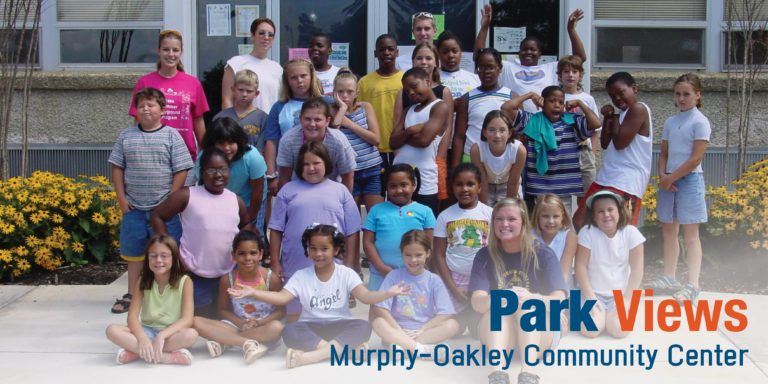This entry is part of Park Views, as Asheville Parks & Recreation series that explores the history of the city’s public parks and community centers – and the mountain spirit that helped make them the unique spaces they are today. Read more from the series and follow APR on Facebook and Instagram for additional photos, upcoming events, and opportunities.
Named for a philanthropic family who helped develop the Oakley neighborhood, Murphy-Oakley Community Center is a product of Asheville’s resiliency following years of stagnation brought on by bank failures in 1930 and the city’s resulting public debt. When previously unincorporated areas became part of the city in 1960, Asheville Parks & Recreation (APR) built new community centers, parks, and recreation programs to serve the new residents including the center in Oakley.
A Neighborhood Among the Oaks
With nearly 7,000 households, Oakley is one of Asheville’s largest modern neighborhoods, but the area was mostly rural with farmland, apple orchards, and cow pastures until the early 20th century.
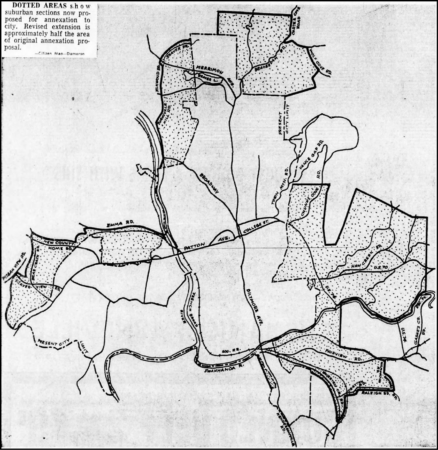 Joseph and Hessie Murphy moved to a farm in the area in 1915. A short time after, they subdivided it into Oakley Park, a development named for plentiful oak trees found in the area. Their former property includes current sites of Oakley Elementary School, Murphy-Oakley Community Center, and much of the land surrounding them. A late 1920s city map shows a well-defined Oakley, with smaller neighborhoods within it including Broad View and Oaklyn.
Joseph and Hessie Murphy moved to a farm in the area in 1915. A short time after, they subdivided it into Oakley Park, a development named for plentiful oak trees found in the area. Their former property includes current sites of Oakley Elementary School, Murphy-Oakley Community Center, and much of the land surrounding them. A late 1920s city map shows a well-defined Oakley, with smaller neighborhoods within it including Broad View and Oaklyn.
Located between Sayles Bleachery and Biltmore, Oakley became home to blue collar workers and middle class families. Many of these residents traveled to Asheville for work, shopping, and entertainment as Oakley was a predominately residential area located outside of city limits. However, Asheville extended its boundary by eight square miles in 1960 to include Oakley and Beverly Hills and parts of Beaverdam, Woodfin, Chunn’s Cove, Haw Creek, Emma, Deaverview, Biltmore Forest, and Deaverview.
West Asheville, Kenilworth, and parts of Oakley were earlier voluntarily annexed by Asheville to consolidate revenue and services. Since Kenilworth residents voted to become part of the larger city in 1929, Asheville’s municipal boundaries remained mostly unchanged, but unregulated development of areas just outside of city limits boomed.
In 1959, Asheville city officials approached Buncombe County’s state delegates with plans to annex Woodfin, Newbridge, Beaverdam, Haw Creek, Chunn’s Cove, Oteen, Beverly Hills, Oakley, Shiloh, Deaverview, Emma, and Bingham Heights and Biltmore Dairy Farms in Biltmore Forest. At the time, state law prevented county governments from making zoning or subdivision regulations. Asheville argued extending city services was necessary to address growth and control urban sprawl.
Asheville would have become the fourth most populous city in North Carolina under the initial proposal, but state officials reduced the annexation by one-third by removing some farmland and mountain areas. Asheville residents and those from the affected neighborhoods voted 3,778 opposed and 6,223 in favor of annexation as the city gained 18,000 new community members. City services such as trash collection, sewer and water, and street maintenance extended to the new areas over the first six months of 1960.
Murphy-Oakley Community Center
As the annexed neighborhoods received police and fire department services, Asheville Fire Department prioritized opening new stations in Oakley and Haw Creek. Hoping to replicate the success of joint fire station, community center, and library buildings that recently opened in North Asheville and West Asheville, the City of Asheville purchased property along Fairview Road from Joseph and Hessie Murphy’s heirs in 1963.
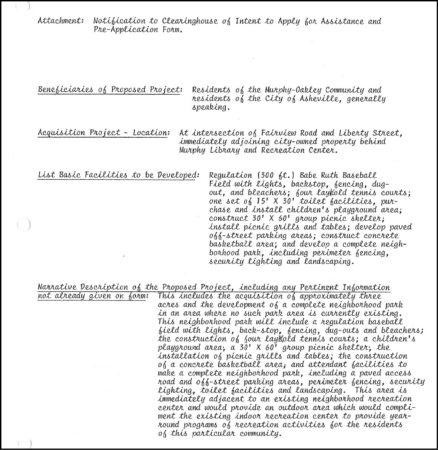 At the time, many households only had one automobile – or no personal vehicle at all – so it made sense for city services to be centralized in highly residential areas rather than separate facilities. Long range plans called for joint fire station and community center buildings throughout Asheville. The end of government mandated segregation and arrival of federal urban renewal programs dramatically changed these plans and by 1966, APR closed Ashland Avenue and Valley Street community centers. Stephens-Lee Community Center (then known as Hill Top Community Center) absorbed most of their programs and Murphy-Oakley Community Center finally received funding in the city’s budget.
At the time, many households only had one automobile – or no personal vehicle at all – so it made sense for city services to be centralized in highly residential areas rather than separate facilities. Long range plans called for joint fire station and community center buildings throughout Asheville. The end of government mandated segregation and arrival of federal urban renewal programs dramatically changed these plans and by 1966, APR closed Ashland Avenue and Valley Street community centers. Stephens-Lee Community Center (then known as Hill Top Community Center) absorbed most of their programs and Murphy-Oakley Community Center finally received funding in the city’s budget.
The new community center opened on May 5, 1968 with a large room, kitchen, and off-street gravel parking lot. Early programs focused on teens and pre-teens with board games, ping pong, television, and dances. It quickly became the permanent meeting location for Asheville-Buncombe Youth Council, but also offered adult activities including china painting and shoe covering. Community groups utilized the building for meetings and special events on a regular basis.
While the surrounding park would be developed later, APR hosted a summer playground site at the nearby Oakley School with arts and crafts, supervised play time, and recreational activities. Opening the library portion of the building was initially delayed until July 1, 1969 to avoid raising taxes. However, that date came and went without a new library branch in Oakley to the dismay of community members.
Until the local library system consolidated as a county government agency in 1980, the City of Asheville and Buncombe County jointly funded the system. City Council eventually included $15,000 for library staff and furniture in the 1972 budget and the Oakley/South Asheville branch opened on January 11 of that year with 3,300 books on its shelves.
Expanding the Center of Community
APR began planning for a park with a ballfield, tennis courts, picnic shelter, restrooms, playground, and paved parking as an expansion of Murphy-Oakley Community Center in 1975. After purchasing adjacent properties, the ballfield opened in 1978 and tennis courts in 1979 by leveraging Housing and Urban Development funds.
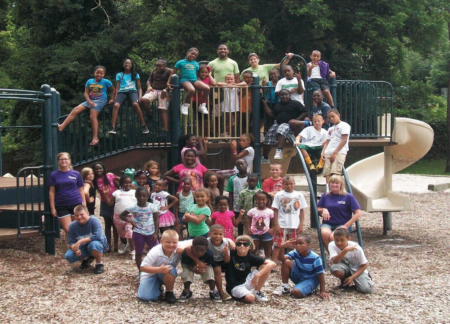 Throughout the 1980s, the community center and park became one of the city’s most visited public spaces with tournaments and leagues using tennis courts and the ballfield, as well as festivals like Mountain Music Day and Gaines Ashley Whippet Dog Frisbee Invitational.
Throughout the 1980s, the community center and park became one of the city’s most visited public spaces with tournaments and leagues using tennis courts and the ballfield, as well as festivals like Mountain Music Day and Gaines Ashley Whippet Dog Frisbee Invitational.
Oakley’s youth softball and baseball programs consolidated with East Asheville’s larger program in 1993. The increased demand for field space brought a sports complex to the Oakley neighborhood just a few miles from the community center, Ray L. Kisiah Park. The playground was replaced in 1996 and Oakley Community and Police Resource Center opened in 1997 in a house that previously served as the residence of the community center’s park ranger.
Today, Murphy-Oakley Community Center is the home to APR’s Therapeutic Recreation programs and OAKS Afterschool. The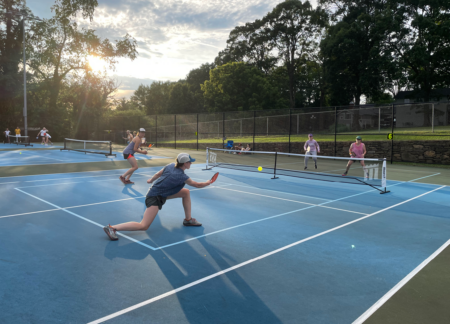 park’s ballfield and recently-renovated basketball and shared use pickleball/tennis courts are almost always in use. In 2024, the playground will reopen as Asheville’s first all-abilities, inclusive playground through a community investment made possible by a general obligation bond referendum approved by voters.
park’s ballfield and recently-renovated basketball and shared use pickleball/tennis courts are almost always in use. In 2024, the playground will reopen as Asheville’s first all-abilities, inclusive playground through a community investment made possible by a general obligation bond referendum approved by voters.
Do you have photos or stories to share about Murphy-Oakley Community Center? Please send them to cbubenik@ashevillenc.gov so APR can be inspired by the past as we plan our future.
Photo and Image Credits
- Intially focused on teens and pre-teens, Murphy-Oakley Community Center has seen thousands of local kids – including these from the early 2000s – thrive as members of APR Afterschool, youth sports, and other programs.
- An illustration from the May 5, 1959 edition of The Asheville Citizen shows proposed expanded city limits that voters approved later in the year.
- Asheville’s public park system embarked on a period of sizable expansion in the 1970s thanks to abundant amounts of federal money focused on improving lives and decreasing the effects of poverty. This is part of an application for funds to create the park that surrounds the Murphy-Oakley Community Center’s building.
- Murphy-Oakley Community Center and Weaver Park had the most visited playgrounds in the city during the 1990s, so APR replaced them with modern, safer equipment in 1996, though this photo is from the 2000s. They were actually dedicated within a day of each other. Both will be completely replaced in 2024 with the community center’s becoming the first all-abilities playground in the APR system.
- With shared use courts that provide space for three tennis matches, six pickleball games, or a combination of both, the courts at Murphy-Oakley are a popular spot for players to connect.
